Indian Army
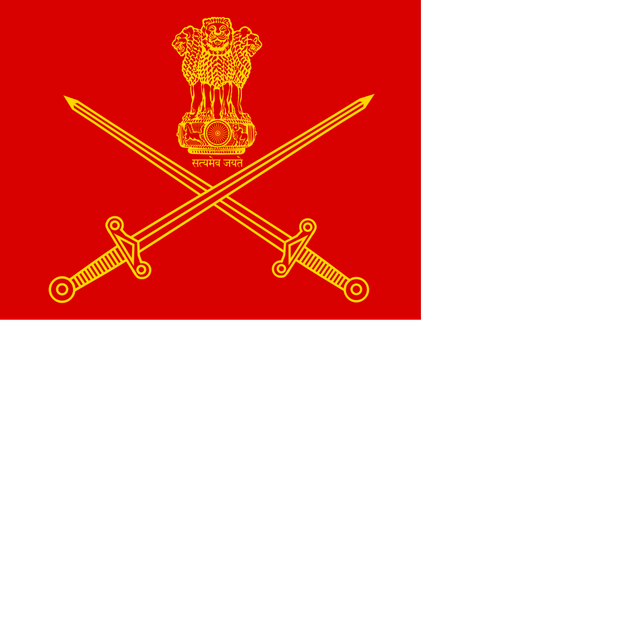
Indian Army

| Indian Army | ||
|---|---|---|
| Founded | 1 April 1895 (1895-04-01) | |
| Country | ||
| Type | Army | |
| Role | Land warfare | |
| Size | 1,237,117 active personnel[4] 960,000 reserve personnel[5] 181 manned aircraft[6] | |
| Part of | Indian Armed Forces | |
| Headquarters | New Delhi | |
| Motto(s) | "Service Before Self" | |
| Colours | Gold, red and black | |
| Anniversaries | Army Day: 15 January | |
| Website | indianarmy.nic.in [188] | |
| Commanders | ||
| Commander-in-Chief | President Ram Nath Kovind | |
| Chief of the Army Staff (COAS) | General Bipin Rawat, PVSM, UYSM, AVSM, YSM, SM, VSM, ADC[7] | |
| Vice Chief of the Army Staff (VCOAS) | Lieutenant General Manoj Mukund Naravane, PVSM, AVSM, SM, VSM[8] | |
| Notable commanders | Field Marshal K. M. Cariappa, OBE Field Marshal Sam Manekshaw, MC General K. S. Thimayya, DSO | |
| Insignia | ||
| Flag | ||
| Aircraft flown | ||
| Attack | HAL Rudra, HAL LCH | |
| Helicopter | HAL Dhruv, HAL Chetak, HAL Cheetah, Kamov Ka-226 | |
Equivalent ranks of Indian military | ||
| Indian Navy | Indian Army | Indian Air Force |
Commissioned ranks | ||
| Admiral of the Fleet | Field Marshal | Marshal of the Air Force |
| Admiral | General | Air Chief Marshal |
| Vice Admiral | Lieutenant General | Air Marshal |
| Rear Admiral | Major General | Air Vice Marshal |
| Commodore | Brigadier | Air Commodore |
| Captain | Colonel | Group Captain |
| Commander | Lieutenant Colonel | Wing Commander |
| Lt. Commander | Major | Squadron Leader |
| Lieutenant | Captain | Flight Lieutenant |
| Sub Lieutenant | Lieutenant | Flying Officer |
Junior commissioned ranks | ||
| Master Chief Petty Officer 1st Class | Subedar Major[1] | Master warrant officer |
| Master Chief Petty Officer 2nd Class | Subedar[2] | Warrant officer |
| Chief Petty Officer | Naib Subedar[3] | Junior warrant officer |
Non-commissioned ranks | ||
| Petty Officer | Havildar | Sergeant |
| Leading Seaman | Naik | Corporal |
| Seaman 1 | Lance Naik | Leading aircraftsman |
| Seaman 2 | Sepoy | Aircraftsman |
Footnotes | ||
The Indian Army (Hindi: Bhāratīya Thala Sēnā) is the land-based branch and the largest component of the Indian Armed Forces. The President of India is the Supreme Commander of the Indian Army,[9] and it is commanded by the Chief of Army Staff (COAS), who is a four-star general. Two officers have been conferred with the rank of field marshal, a five-star rank, which is a ceremonial position of great honour. The Indian Army originated from the armies of the East India Company, which eventually became the British Indian Army, and the armies of the princely states, which finally became the national army after independence. The units and regiments of the Indian Army have diverse histories and have participated in a number of battles and campaigns across the world, earning many battle and theatre honours before and after Independence.[10]
The primary mission of the Indian Army is to ensure national security and national unity, defending the nation from external aggression and internal threats, and maintaining peace and security within its borders. It conducts humanitarian rescue operations during natural calamities and other disturbances, like Operation Surya Hope, and can also be requisitioned by the government to cope with internal threats. It is a major component of national power alongside the Indian Navy and the Indian Air Force.[11] The army has been involved in four wars with neighbouring Pakistan and one with China. Other major operations undertaken by the army include: Operation Vijay, Operation Meghdoot and Operation Cactus. Apart from conflicts, the army has conducted large peace time exercises like Operation Brasstacks and Exercise Shoorveer, and it has also been an active participant in numerous United Nations peacekeeping missions including those in: Cyprus, Lebanon, Congo, Angola, Cambodia, Vietnam, Namibia, El Salvador, Liberia, Mozambique, South Sudan and Somalia.
The Indian Army has a regimental system, but is operationally and geographically divided into seven commands, with the basic field formation being a division. It is an all-volunteer force and comprises more than 80% of the country's active defence personnel. It is the 2nd largest standing army in the world, with 1,237,117[12][13] active troops and 960,000 reserve troops.[14][15] The army has embarked on an infantry modernisation program known as Futuristic Infantry Soldier As a System (F-INSAS), and is also upgrading and acquiring new assets for its armoured, artillery and aviation branches.[16][17][18]
| Indian Army | ||
|---|---|---|
| Founded | 1 April 1895 (1895-04-01) | |
| Country | ||
| Type | Army | |
| Role | Land warfare | |
| Size | 1,237,117 active personnel[4] 960,000 reserve personnel[5] 181 manned aircraft[6] | |
| Part of | Indian Armed Forces | |
| Headquarters | New Delhi | |
| Motto(s) | "Service Before Self" | |
| Colours | Gold, red and black | |
| Anniversaries | Army Day: 15 January | |
| Website | indianarmy.nic.in [188] | |
| Commanders | ||
| Commander-in-Chief | President Ram Nath Kovind | |
| Chief of the Army Staff (COAS) | General Bipin Rawat, PVSM, UYSM, AVSM, YSM, SM, VSM, ADC[7] | |
| Vice Chief of the Army Staff (VCOAS) | Lieutenant General Manoj Mukund Naravane, PVSM, AVSM, SM, VSM[8] | |
| Notable commanders | Field Marshal K. M. Cariappa, OBE Field Marshal Sam Manekshaw, MC General K. S. Thimayya, DSO | |
| Insignia | ||
| Flag | ||
| Aircraft flown | ||
| Attack | HAL Rudra, HAL LCH | |
| Helicopter | HAL Dhruv, HAL Chetak, HAL Cheetah, Kamov Ka-226 | |
Equivalent ranks of Indian military | ||
| Indian Navy | Indian Army | Indian Air Force |
Commissioned ranks | ||
| Admiral of the Fleet | Field Marshal | Marshal of the Air Force |
| Admiral | General | Air Chief Marshal |
| Vice Admiral | Lieutenant General | Air Marshal |
| Rear Admiral | Major General | Air Vice Marshal |
| Commodore | Brigadier | Air Commodore |
| Captain | Colonel | Group Captain |
| Commander | Lieutenant Colonel | Wing Commander |
| Lt. Commander | Major | Squadron Leader |
| Lieutenant | Captain | Flight Lieutenant |
| Sub Lieutenant | Lieutenant | Flying Officer |
Junior commissioned ranks | ||
| Master Chief Petty Officer 1st Class | Subedar Major[1] | Master warrant officer |
| Master Chief Petty Officer 2nd Class | Subedar[2] | Warrant officer |
| Chief Petty Officer | Naib Subedar[3] | Junior warrant officer |
Non-commissioned ranks | ||
| Petty Officer | Havildar | Sergeant |
| Leading Seaman | Naik | Corporal |
| Seaman 1 | Lance Naik | Leading aircraftsman |
| Seaman 2 | Sepoy | Aircraftsman |
Footnotes | ||
History
British Indian Army
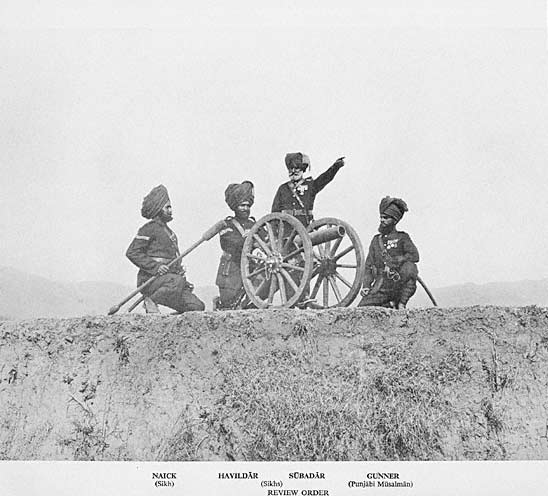
No. 4 (Hazara) Mountain Battery with RML7 pounder "Steel Gun" Mountain Gun in Review Order. Left to right Naick, Havaldar, Subadar (Sikhs) and Gunner (Punjabi Musalman) circa 1895.
A Military Department was created within the Government of the East India Company at Kolkata in the year 1776. Its main function was to sift and record orders relating to the Army that were issued by various Departments of the East India Company for the territories under its control.[19]
With the Charter Act of 1833, the Secretariat of the Government of the East India Company was reorganised into four Departments, including a Military Department. The army in the Presidencies of Bengal, Bombay and Madras functioned as respective Presidency Armies until 1 April 1895 when they were unified into a single Indian Army.[20][21][22][23] For administrative convenience, it was divided into four commands at that point, namely Punjab (including the North West Frontier), Bengal, Madras (including Burma) and Bombay (including Sind, Quetta and Aden).[24]
The British Indian Army was a critical force for the primacy of the British Empire both in India and across the world. Besides maintaining the internal security of the British Raj, the Army fought in many other theatres: the Anglo-Burmese Wars, First and Second Anglo-Sikh Wars, First, Second and Third Anglo-Afghan Wars, First and Second Opium Wars in China, Abyssinia, and the Boxer Rebellion in China.
World wars
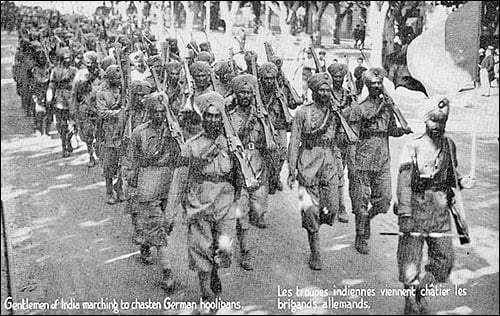
French postcard depicting the arrival of 15th Sikh Regiment in France during World War I. The postcard reads, "Gentlemen of India marching to chasten the German hooligans."
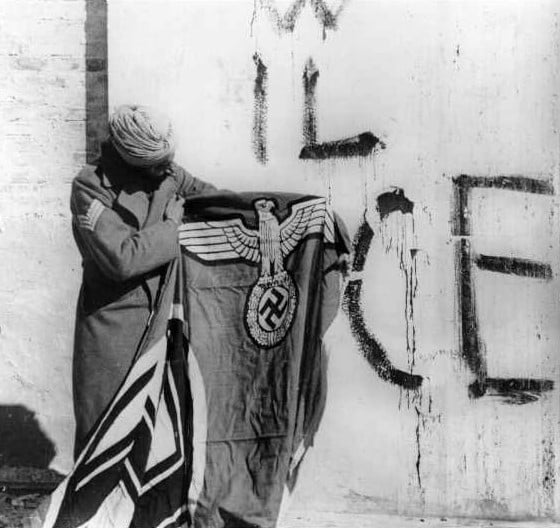
A Sikh soldier of the 4th Division (the Red Eagles) of the Indian Army, attached to the British Fifth Army in Italy. Holding a captured swastika after the surrender of German forces in Italy, May 1945. Behind him, a fascist inscriptions says "VIVA IL DUCE", "Long live the Duce" (i.e. Mussolini).
In the 20th century, the Indian Army was a crucial adjunct to the British forces in both world wars. 1.3 million Indian soldiers served in World War I (1914–1918) with the Allies, in which 74,187 Indian troops were killed or missing in action.[25] In 1915 there was a mutiny by Indian soldiers in Singapore. The United Kingdom made promises of self-governance to the Indian National Congress in return for its support but reneged on them after the war, following which the Indian Independence movement gained strength.
The "Indianisation" of the British Indian Army began with the formation of the Prince of Wales Royal Indian Military College at Dehradun in March 1912 with the purpose of providing education to the scions of aristocratic and well-to-do Indian families, and to prepare selected Indian boys for admission into the Royal Military College, Sandhurst. Indian officers were given a King's commission after passing out and were posted to one of the eight units selected for Indianisation. Because of the slow pace of Indianisation, with just 69 officers being commissioned between 1918 and 1932, political pressure was applied leading to the formation of the Indian Military Academy in 1932 and greater numbers of officers of Indian origin being commissioned.[26]
In World War II Indian soldiers fought alongside the Allies. In 1939, British officials had no plan for expansion and training of Indian forces, which comprised about 130,000 men (in addition there were 44,000 men in British units in India in 1939). Their mission was internal security and defence against a possible Soviet threat through Afghanistan. As the war progressed, the size and role of the Indian Army expanded dramatically, and troops were sent to battlefronts as soon as possible. The most serious problem was lack of equipment.[27] Indian units served in Burma, where in 1944–45, five Indian divisions were engaged along with one British and three African divisions. Even larger numbers operated in the Middle East. Some 87,000 Indian soldiers died in the war. By the end of the war it had become the largest volunteer army in history, rising to over 2.5 million men in August 1945.[28][29]
In the African and Middle-Eastern Campaigns, captured Indian troops were given a choice to join the German Army to eventually "liberate" India from Great Britain instead of being sent to POW camps. These men, along with Indian students who were in Germany when the war broke out, made up what was called the Free India Legion. They were originally intended as pathfinders for German forces in Asia, but were soon sent to help guard the Atlantic Wall. Few who were part of the Free India Legion ever saw any combat, and very few were ever stationed outside Europe. At its height the Free India Legion had over 3,000 troops in its ranks.[30]
Indian POWs also joined the Indian National Army which was allied with the Empire of Japan. It was raised by a former colonel of the British Indian Army (Gen) Mohan Singh, but later led by Netaji Subhas Chandra Bose and Rash Bihari Bose. With the fall of Singapore in 1942, about 40,000 Indian soldiers were captured. They were given a choice and over 30,000 joined the Indian National Army. Those who refused became POWs and were mostly shipped to New Guinea.[31] After initial success it was defeated along with the Japanese, but it had a huge impact on the Indian independence movement. Similar organisations were also formed in Germany and Japan.
Independence
Upon independence and the subsequent Partition of India in 1947, four of the ten Gurkha regiments were transferred to the British Army. The rest of the British Indian Army was divided between the newly created nations of India and Pakistan. The Punjab Boundary Force, which had been formed to help police the Punjab during the partition period, was disbanded,[32] and Headquarters Delhi and East Punjab Command was formed to administer the area.
The departure of virtually all senior British officers following independence and their replacement by Indian officers meant many of the latter held acting ranks several ranks above their substantive ones. For instance, S. M. Shrinagesh, the ground forces commander of Indian forces during the first Indo-Pak War of 1947-49 (and the future third COAS) was first an acting major-general and then an acting lieutenant-general during the conflict while holding the substantive rank of major, and only received a substantive promotion to lieutenant-colonel in August 1949.[33] Gopal Gurunath Bewoor, the future ninth COAS, was an acting colonel at his promotion to substantive major from substantive captain in 1949, while future lieutenant-general K. P. Candeth was an acting brigadier (substantive captain) at the same time.[34]
Army Day is celebrated on 15 January every year in India, in recognition of Lieutenant General K. M. Cariappa's taking over as the first commander-in-chief of the Indian Army from General Sir Francis Butcher, the last British commander-in-chief of India, on 15 January 1949. With effect from 26 January 1950, the date India became a republic, all active-duty Indian Army officers formerly holding the King's Commission were recommissioned and confirmed in their substantive ranks.[35]
Conflicts and operations
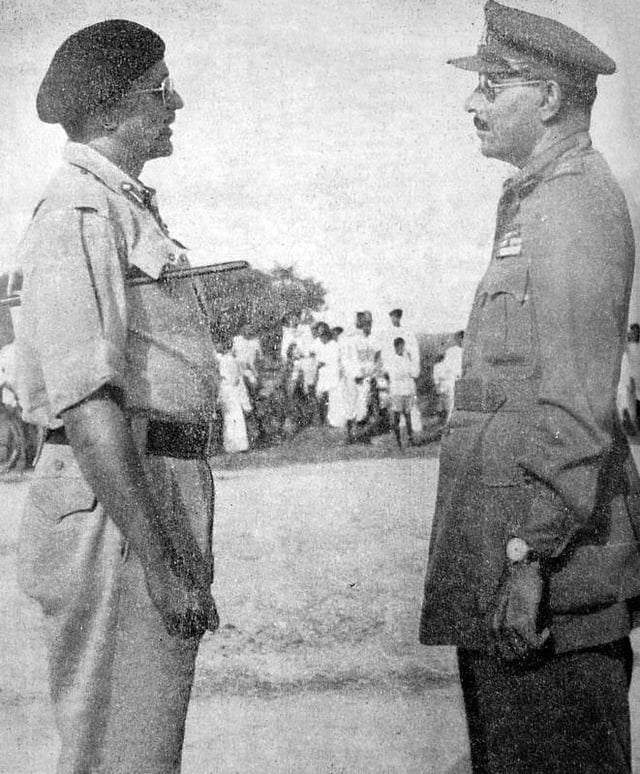
Major General El Edroos (at right) offers his surrender of the Hyderabad State Forces to Major General (later Army Chief) J.N. Chaudhuri at Secunderabad
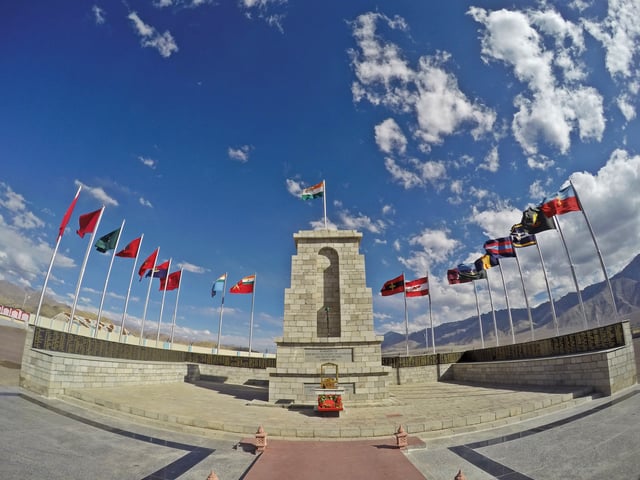
Indian Army Hall of Fame at Leh, near Indo-Tibet border
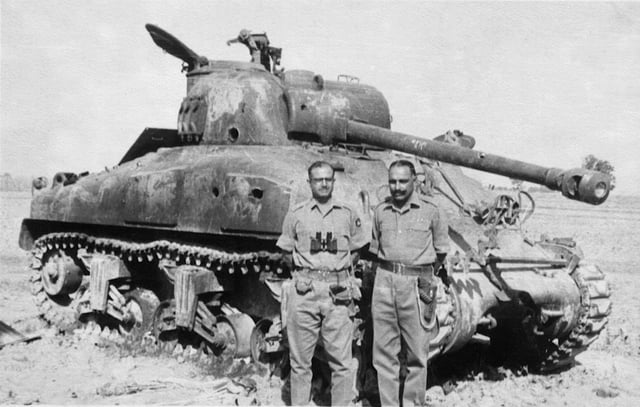
Indian Army officer next to a destroyed Pakistani Sherman tank, after the battle of Asal Uttar.
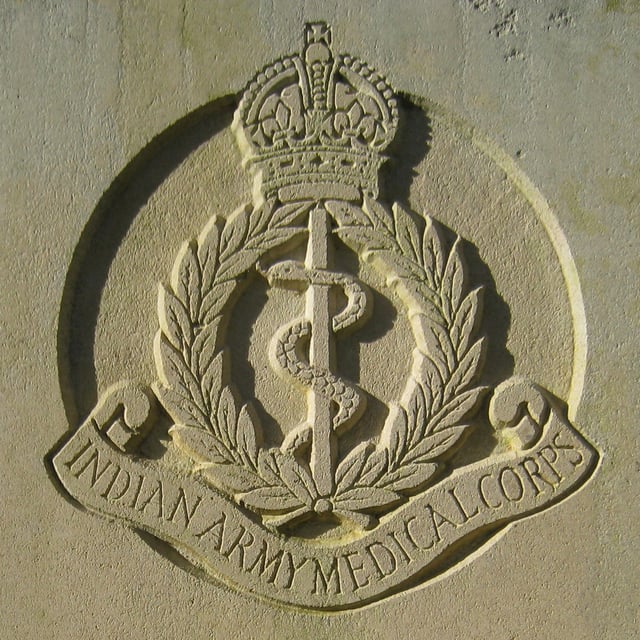
A memorial for the 22 Indian Army Medical Corps at the War Cemetery in Taiping, Perak.

Kargil War Memorial looking at National Highway 1 from the foot of Tololing

Kargil War Memorial, built to honor fallen soldiers.
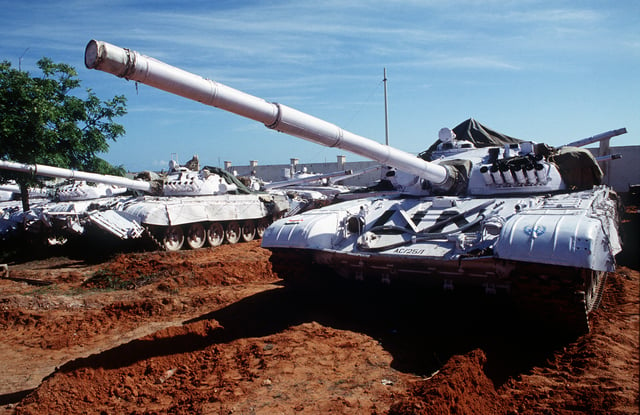
Indian T-72 armored tanks in Somalia, as part of the UN peacekeeping mission.
First Kashmir War (1947)
Immediately after independence, tensions between India and Pakistan began to boil over, and the first of three full-scale wars between the two nations broke out over the then princely state of Kashmir. The Maharaja of Kashmir wanted to have a standstill position. Since Kashmir was a Muslim majority state, Pakistan wanted to make Kashmir a Pakistani territory. As a result, Pakistan invaded Kashmir on 22 October 1947, causing Maharaja Hari Singh to look to India, specifically to Lord Mountbatten of Burma, the governor general, for help. He signed the Instrument of Accession to India on 26 October 1947. Indian troops were airlifted to Srinagar from 27 October dawn onwards.[36] This contingent included General Thimayya who distinguished himself in the operation and in the years that followed became a Chief of the Indian Army. An intense war was waged across the state and former comrades found themselves fighting each other. Pakistan suffered significant losses. Its forces were stopped on the line formed which is now called LOC (Line of Control). An uneasy UN sponsored peace returned by the end of 1948 with Indian and Pakistani soldiers facing each other directly on the Line of Control, which has since divided Indian-held Kashmir from Pakistan-held Kashmir. A number of UN resolutions (38–47) were passed calling for a plebiscite to be held in Kashmir to determine accession to India or Pakistan only after Pakistan withdrew its army from Kashmir.[37] A precondition to the resolution was for Pakistan and India to return to a state of "as was" prior to the conflict. Pakistan would withdraw all tribesmen and Pakistani nationals brought in to fight in Kashmir. With Pakistan refusing to pull back there could be no further dialogue on fulfilling the UN resolution.[38][37] Tensions between India and Pakistan, largely over Kashmir, have never been entirely eliminated.
Annexation of Hyderabad (1948)
After the partition of India, the State of Hyderabad, a princely state under the rule of a Nizam, chose to remain independent. The Nizam, refused to accede his state to the Union of India. The following stand-off between the Government of India and the Nizam ended on 12 September 1948 when India's then deputy Prime Minister Sardar Vallabhbhai Patel ordered Indian troops to secure the state. During five days of fighting, the Indian Army, backed by an Indian Air Force squadron of Hawker Tempest aircraft, routed the Hyderabad State forces. Five Indian Army infantry battalions and one armoured squadron were engaged in the operation. The following day, the State of Hyderabad was proclaimed as a part of the Union of India. Major General Joyanto Nath Chaudhuri, who led the Operation Polo and accepted the surrender of the Nizam's forces on 18 September 1948, was appointed the military governor of Hyderabad (1948–1949) to restore law and order.
Medical assistance during Korean War (1950–1953)
During the Korean War, India sent the 60th Indian (Parachute) Field Ambulance unit to aid the UN troops fighting against the Chinese and North Korean invasion of South Korea, though they decided against sending combat forces. The 60th PFA was included in the 1st Commonwealth Division. In the aftermath of the war, an Indian infantry brigade formed the Custodian Force of India as some of the soldiers were also sent to Korea as part of the Neutral Nations Repatriation Committee to assist in the exchange of prisoners of war. The NNRC was commanded by Lt Gen KS Thimayya.
Annexation of Goa, Daman and Diu (1961)
Even though the British and French vacated all their colonial possessions in the Indian subcontinent, Portugal refused to relinquish control of its Indian colonies of Goa, Daman and Diu. After repeated attempts by India to negotiate with Portugal for the territory were spurned by Portuguese prime minister and dictator, António de Oliveira Salazar, India launched Operation Vijay on 12 December 1961 to take Goa from the Portuguese. A small contingent of its troops entered Goa, Daman, and Diu to capture and secure the territory. After a brief conflict, in which 31 Portuguese soldiers were killed, the Portuguese Navy frigate NRP Afonso de Albuquerque destroyed, and over 3,000 Portuguese captured, Portuguese General Manuel António Vassalo e Silva surrendered to Maj Gen KP Candeth (Kunhiraman Palat Kandoth) of the Indian Army, after twenty-six hours. Goa, Daman and Diu became a part of the Republic of India.
Sino-Indian War (1962)
The cause of this war was a dispute over the sovereignty of the widely separated Aksai Chin and Arunachal Pradesh border regions. Aksai Chin, claimed by India to belong to Kashmir, and by China to be part of Xinjiang, contains an important road link that connects the Chinese regions of Tibet and Xinjiang. China's construction of this road was one of the triggers of the conflict.
Small-scale clashes between Indian and Chinese forces broke out as India insisted on the disputed McMahon Line being regarded as the international border between the two countries. Chinese troops claimed not to have retaliated to the cross-border firing by Indian troops, despite sustaining losses.[39] China's suspicion of India's involvement in Tibet created more rifts between the two countries.[40]
In 1962, the Indian Army was ordered to move to the Thag La ridge located near the border between Bhutan and Arunachal Pradesh and about three miles (5 km) north of the disputed McMahon Line. Meanwhile, Chinese troops had also made incursions into Indian-held territory, and tensions between the two reached a new high when Indian forces discovered a road constructed by China in Aksai Chin. After a series of failed negotiations, the People's Liberation Army attacked Indian Army positions at the Thag La ridge. This move by China caught India by surprise and by 12 October, Nehru gave orders for the Chinese to be expelled from Aksai Chin. However, poor co-ordination among various divisions of the Indian Army, and the late decision to mobilise the Indian Air Force in vast numbers, gave China a crucial tactical and strategic advantage over India. On 20 October, Chinese soldiers attacked India in both the North-West and North-Eastern parts of the border and captured vast portions of Aksai Chin and Arunachal Pradesh.
As the fighting moved beyond disputed territories, China called on the Indian government to negotiate, however India remained determined to regain lost territory. With no peaceful agreement in sight, China unilaterally withdrew its forces from Arunachal Pradesh. The reasons for the withdrawal are disputed with India claiming various logistical problems for China and diplomatic support from the United States, while China stated that it still held territory it had staked diplomatic claim over. The dividing line between the Indian and Chinese forces was named the Line of Actual Control.
The poor decisions made by India's military commanders and, its political leadership, raised several questions. The Henderson-Brooks & Bhagat committee was soon set up by the Government of India to determine the causes of the poor performance of the Indian Army. Its report criticised the decision not to allow the Indian Air Force to target Chinese transport lines out of fear of a Chinese aerial counter-attack on Indian civilian areas. Much of the blame was also targeted at the incompetence of then-Defence Minister, Krishna Menon who resigned from his post soon after the war ended. Despite frequent calls for its release, the Henderson-Brooks report still remains classified.[41] Neville Maxwell has written an account of the war.[42]
Indo-Pakistani War of 1965
A second confrontation with Pakistan took place in 1965. Although the war is described as inconclusive, India had the better of the war and was a clear winner in tactical and strategic terms.[43][44][45] Pakistani President Ayub Khan launched Operation Gibraltar in August 1965, during which several Pakistani paramilitary troops infiltrated into Indian-administered Kashmir and attempt to ignite an anti-India agitation in Jammu and Kashmir. Pakistani leaders believed that India, which was still recovering from the disastrous Sino-Indian War, would be unable to deal with a military thrust and a Kashmiri rebellion. India reacted swiftly and launched a counter offensive on Pakistan. Pakistan launched Operation Grand Slam in reply on 1 September, invading India's Chamb-Jaurian sector. In retaliation, the Indian Army launched a major offensive throughout its border with Pakistan, with Lahore as its prime target.
Initially, the Indian Army met with considerable success in the northern sector. After launching prolonged artillery barrages against Pakistan, India was able to capture three important mountain positions in Kashmir. By 9 September, the Indian Army had made considerable in-roads into Pakistan. India had its largest haul of Pakistani tanks when the offensive of Pakistan's 1st Armoured Division was blunted at the Battle of Asal Uttar, which took place on 10 September near Khemkaran.[46] The biggest tank battle of the war came in the form of the Battle of Chawinda, the largest tank battle in history after World War II. Pakistan's defeat at the Battle of Asal Uttar hastened the end of the conflict.[46]
At the time of ceasefire declaration, per neutral sources, India reported casualties of about 3,000. On the other hand, it was estimated that more than 3,800 Pakistani soldiers were killed in the battle.[47][48][49] About 200-300 Pakistani tanks were either destroyed or captured by India. India lost a total of 150-190 tanks during the conflict.[46][50] The decision to return to pre-war positions, following the Tashkent Declaration, caused an outcry among the polity in New Delhi. It was widely believed that India's decision to accept the ceasefire was due to political factors, and not military, since it was facing considerable pressure from the United States and the UN to stop hostilities.[51]
1967 Sino-Indian conflict
The 1967 Sino-Indian skirmish, also known as the Cho La incident, was a military conflict between Indian troops and members of the Chinese People's Liberation Army who had infiltrated on 1 October 1967 in Sikkim, then a protectorate of India. On 10 October, both sides clashed again. Defence Minister Sardar Swaran Singh assured the Indian people that the government was taking care of developments along the border. In the aftermath of the conflict Indian losses were 88 killed, and 163 wounded, while Chinese casualties were 300 killed and 450 wounded in Nathula, and 40 in Chola.[52] The Chinese Army left Sikkim after being defeated by Indian troops.[53][54][55]
Operation against the Naxalites during 1971
Under the supervision of Indira Gandhi during the president's rule in 1971, the Indian Army and the Indian police launched Operation Steeplechase, a gigantic "counter-insurgency" operation against the Naxalites, which resulted in the death of hundreds of Naxalites and the imprisonment of more than 20,000 suspects and cadres including senior leaders.[56] The army was also assisted by a brigade of para commandos and the Indian paramilitary. The operation was organised in October 1969, and Lieutenant General J.F.R. Jacob was enjoined by Govind Narain, the home secretary of India, that "there should be no publicity and no records" and Jacob's request to be presented with written orders was also repudiated by Sam Manekshaw.[57]
Bangladesh Liberation War of 1971
An independence movement broke out in East Pakistan which was crushed by Pakistani forces. Due to large-scale atrocities against them, thousands of Bengalis took refuge in neighbouring India causing a major refugee crisis there. In early 1971, India declared its full-support for the Bengali rebels, known as Mukti Bahini, and Indian agents were extensively involved in covert operations to aid them.
On 20 November 1971, the Indian Army moved the 14 Punjab Battalion 45 Cavalry into Garibpur, a strategically important town near India's border with East Pakistan, and successfully captured it. The following day, more clashes took place between Indian and Pakistani forces. Wary of India's growing involvement in the Bengali rebellion, the Pakistan Air Force (PAF) launched a preemptive strike on 10 Indian air bases at: Srinagar, Jammu, Pathankot, Amritsar, Agra, Adampur, Jodhpur, Jaisalmer, Uttarlai and Sirsa at 17:45 hours on 3 December. However, this aerial offensive failed to accomplish its stated objectives, and gave India an excuse to declare a full-scale war against Pakistan the same day. By midnight, the Indian Army, accompanied by the Indian Air Force, launched a major three-pronged assault into East Pakistan. The Indian Army won several battles on the eastern front including the decisive battle of Hilli, which was the only front where the Pakistani Army was able to build up considerable resistance. The operation also included a battalion-level airborne operation on Tangail, which resulted in the capitulation of all resistance within five days.[58] India's massive early gains were attributed largely to the speed and flexibility with which Indian armoured divisions moved across East Pakistan.[59]
Pakistan launched a counter-attack against India on the western front. On 4 December 1971, the A company of the 23rd Battalion of India's Punjab Regiment detected and intercepted the movement of the 51st Infantry Brigade of the Pakistani Army near Ramgarh, Rajasthan. The battle of Longewala ensued during which the A company, though being outnumbered, thwarted the Pakistani advance until the Indian Air Force directed its fighters to engage the Pakistani tanks. By the time the battle had ended, 38 Pakistani tanks and 100 armoured vehicles were either destroyed or abandoned. About 200 Pakistani troops were killed in action during the battle while two Indian soldiers lost their lives. Pakistan suffered another major defeat on the western front during the battle of Basantar which was fought from 4 December to the 16th. By the end of the battle, about 66 Pakistani tanks were destroyed and 40 more were captured. In return, Pakistani forces were able to destroy only 11 Indian tanks. None of the many Pakistani offensives on the western front materialised.[60] By 16 December, Pakistan had lost sizeable territory on both the eastern and western fronts.
Under the command of Lt. General J.S. Arora, the three corps of the Indian Army, which had invaded East Pakistan, entered Dhaka and forced Pakistani forces to surrender on 16 December 1971, one day after the conclusion of the battle of Basantar. After Pakistan's Lt General A A K Niazi signed the Instrument of Surrender, India took more than 90,000 Pakistani prisoners of war. By the time of the signing, 11,000 Pakistani soldiers were killed-in-action while India suffered 3,500 battle-related deaths.[48] In addition, Pakistan lost 220 tanks during the battle compared to India's 69.[61]
In 1972, the Simla Agreement was signed between the two countries and tensions simmered. However, there were occasional spurts in diplomatic tensions which culminated in increased military vigilance on both sides.
Siachen conflict (1984)
The Siachen Glacier, though a part of the Kashmir region, was not officially demarcated on maps prepared and exchanged between the two sides in 1947. As a consequence, prior to the 1980s, neither India nor Pakistan maintained any permanent military presence in the region. However, Pakistan began conducting and allowing a series of mountaineering expeditions to the glacier beginning in the 1950s. By the early 1980s, the Government of Pakistan was granting special expedition permits to mountaineers and United States Army maps deliberately showed Siachen as a part of Pakistan. This practice gave rise to the contemporary meaning of the term oropolitics.
India, possibly irked by these developments, launched Operation Meghdoot in April 1984. An entire battalion of the Kumaon Regiment was airlifted to the glacier. Pakistani forces responded quickly and clashes between the two followed. The Indian Army secured the strategic Sia La and Bilafond La mountain passes, and by 1985 more than 1,000 square miles (2,600 km2) of territory 'claimed' by Pakistan was under Indian control.[62] The Indian Army continues to control all the Siachen Glacier and its tributary glaciers. Pakistan made several unsuccessful attempts to regain control over Siachen. In late 1987, Pakistan mobilised about 8,000 troops and garrisoned them near Khapalu, aiming to capture Bilafond La.[63] However, they were repulsed by Indian Army personnel guarding Bilafond. During the battle, about 23 Indian soldiers lost their lives, while more than 150 Pakistani troops perished.[64] Further unsuccessful attempts to reclaim positions were launched by Pakistan in 1990, 1995, 1996 and 1999, most notably in Kargil that year.
India continues to maintain a strong military presence in the region, despite extremely inhospitable conditions. The conflict over Siachen is regularly cited as an example of mountain warfare.[65][66] The highest peak in the Siachen glacier region, Saltoro Kangri, could be viewed as strategically important for India because of its immense altitude which could enable the Indian forces to monitor some Pakistani or Chinese movements in the immediate area.[67] Maintaining control over Siachen poses several logistical challenges for the Indian Army. Several infrastructure projects were constructed in the region, including a helipad at 21,000 feet (6,400 m) above the sea level.[68] In 2004, the Indian Army was spending an estimated US$2 million a month to support its personnel stationed in the region.[69]
Counter-insurgency activities
The Indian Army has played a crucial role in the past, fighting insurgents and terrorists within the nation. The army launched Operation Blue Star and Operation Woodrose in the 1980s to combat Sikh insurgents. The army, along with some paramilitary forces, has the prime responsibility of maintaining law and order in the troubled Jammu and Kashmir region, led specifically by the Northern Command. The Indian Army also sent a contingent to Sri Lanka in 1987 as a part of the Indian Peace Keeping Force.[70][71][72] The Indian Army also successfully conducted Operation Golden Bird in 1995 for counter-insurgency in northeast India.[73]
Kargil war (1999)
In 1998, India carried out nuclear tests and a few days later, Pakistan responded with more nuclear tests giving both countries nuclear deterrence capability, although India had tested one hydrogen bomb which Pakistan lacked. Diplomatic tensions eased after the Lahore Summit was held in 1999. However, the sense of optimism was short-lived since in mid-1999 Pakistani paramilitary forces and Kashmiri insurgents captured the deserted, but strategic, Himalayan heights in the Kargil district of India. These had been vacated by the Indian army during the onset of the inhospitable winter and were supposed to be reoccupied in spring. The regular Pakistani troops who took control of these areas received important support, both in the form of arms and supplies, from Pakistan. Some of the heights under their control, which also included the Tiger Hill, overlooked the vital Srinagar-Leh Highway (NH 1A), Batalik and Dras.
Once the scale of the Pakistani incursion was realised, the Indian Army quickly mobilised about 200,000 troops and Operation Vijay was launched. However, since the heights were under Pakistani control, India was at a clear strategic disadvantage. From their observation posts, the Pakistani forces had a clear line-of-sight to lay down indirect artillery fire on NH 1A, inflicting heavy casualties on the Indians.[74] This was a serious problem for the Indian Army as the highway was its main logistical and supply route.[75] Thus, the Indian Army's first priority was to recapture peaks that were in the immediate vicinity of NH 1A. This resulted in Indian troops first targeting the Tiger Hill and Tololing complex in Dras.[76] This was soon followed by more attacks on the Batalik-Turtok sub-sector which provided access to Siachen Glacier. Point 4590, which had the nearest view of the NH 1A, was successfully recaptured by Indian forces on 14 June.[77]
Though most of the posts in the vicinity of the highway were cleared by mid-June, some parts of it near Dras witnessed sporadic shelling until the end of the war. Once the NH 1A area was cleared, the Indian Army turned to driving the invading force back across the Line of Control. The Battle of Tololing, among other assaults, slowly tilted the combat in India's favour. Nevertheless, some posts put up a stiff resistance, including Tiger Hill (Point 5140) that fell only later in the war. As the operation was fully under way, about 250 artillery guns were brought in to clear the infiltrators in the posts that were in the line-of-sight. At many vital points, neither artillery nor air power could dislodge the outposts manned by the Pakistan soldiers, who were out of visible range. The Indian Army mounted some direct frontal ground assaults which were slow and took a heavy toll given the steep ascent that had to be made on peaks as high as 18,000 feet (5,500 m). Two months into the conflict, Indian troops had slowly retaken most of the ridges they had lost;[78][79] according to official count, an estimated 75%–80% of the intruded area, and nearly all high ground, was back under Indian control.
Following the Washington accord on 4 July, where Sharif agreed to withdraw Pakistani troops, most of the fighting came to a gradual halt, but some Pakistani forces remained in positions on the Indian side of the LOC. In addition, the United Jihad Council (an umbrella for all extremist groups) rejected Pakistan's plan for a climb-down, instead deciding to fight on.[80] The Indian Army launched its final attacks in the last week of July; as soon as the Dras sub-sector had been cleared of Pakistani forces, the fighting ceased on 26 July. The day has since been marked as Kargil Vijay Diwas (Kargil Victory Day) in India. By the end of the war, India had resumed control of all the territory south and east of the Line of Control, as was established in July 1972 per the Shimla Accord. By the time all hostilities had ended, the number of Indian soldiers killed during the conflict stood at 527,[81] while more than 700 regular members of the Pakistani Army were killed.[82] The number of Islamist fighters, also known as Mujahideen, killed by Indian Armed Forces during the conflict stood at about 3,000.
United Nations peacekeeping missions
India has been the largest troop contributor to UN missions since its inception. So far India has taken part in 43 Peacekeeping missions with a total contribution exceeding 160,000 troops and a significant number of police personnel having been deployed. In 2014 India is the third largest troop contributor [TCC] with 7,860 personnel deployed with ten UN Peacekeeping Missions of which 995 are police personnel, including the first Female Formed Police Unit under the UN.[83] The Indian Army has undertaken numerous UN peacekeeping missions.[84] As of 30 June 2014, 157 Indians have been killed during such operations.[85] The Indian army has also provided paramedical units to facilitate the withdrawal of the sick and wounded.
Indo-China Doklam issue
Major exercises

Yudh Abhyas 2012 – US and Indian Army military exercise Trailer.
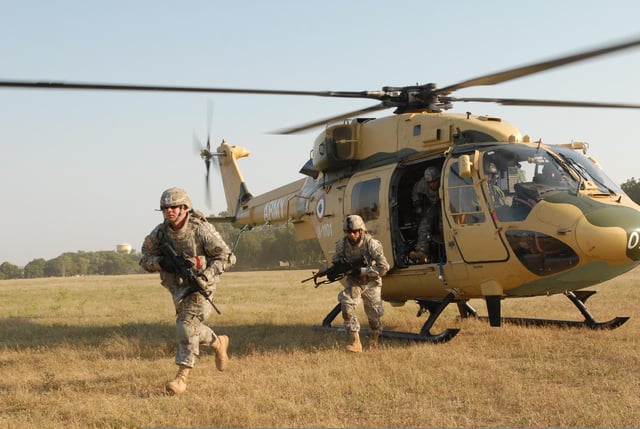
Indian Army Aviation Corps Dhruv helicopter ferrying U.S soldiers during the Yudh Abhyas training exercise in 2009.

Indian army armoured vehicles during Yudh Abhyas exercises
Operation Brasstacks
Operation Brasstacks was launched by the Indian Army in November 1986 to simulate a full-scale war on its western border. The exercise was the largest ever conducted in India and comprised nine infantry, three mechanised, three armoured and one air assault division, and included three independent armoured brigades. Amphibious assault exercises were also conducted with the Indian Navy. Brasstacks also allegedly incorporated nuclear attack drills. It led to tensions with Pakistan and a subsequent rapprochement in mid-1987.[86][87]
Exercise Ashwamedha
Yudh Abhyas
Exercise Yudh Abhyas is part of an ongoing series of joint exercises between the Indian and United States Armies since 2005, agreed upon under the New Framework of the India-US Defence Relationship. Commencing at the platoon level, the exercise has graduated to a command post (CPX) and field training exercise (FTX).
The seventh edition of Yudh Abhyas is currently underway since 5 March 2012 in two locations under the South Western Command. The US Army contingent is from the US Army Pacific (USARPAC), part of the United States Pacific Command (USPACOM). The Command Post Exercise has an engineer brigade headquarters with its planners from both sides, while the Field Training Exercise comprises troops of the 2nd Squadron 14th US Cavalry Regiment from the 25th Infantry Division, Hawaii, along with a platoon of Strykers, and a similar sized Indian Army contingent of mechanised infantry. The event is all the more interesting as a number of key surveillance, communications and Improvised Explosive Devices detection and neutralisation technologies, available to both sides have been fielded in the exercise.[90]
An Indian-born US Army linguist and translator assigned to the John F. Kennedy Special Warfare Center and School, explains weapons-range safety procedures to Indian Army soldiers with the 99th Mountain Brigade before they fire American machine guns 4 May 2013, at Fort Bragg, N.C. They are part of Yudh Abhyas 2013, the latest annual training event between the armies of India and the United States, sponsored by US Army Pacific. [91] [92]
The eighth edition of Yudh Abhyas was conducted with The Indian army's 99th Mountain Brigade and the 1st Bde. Combat Team, 82nd Airborne Division at Fort Bragg, N.C. Other units represented were the 3rd Squadron, 73rd Cavalry Regiment, from the US forces, and from India, the 2nd Battalion, 5th Gurka Rifles; the 50th Independent Para Bde.; and the 54th Engineers Regt. The U.S. Army-Pacific sponsored a bilateral training exercise with the Indian army, 3–17 May 2013, that focused on the two countries' cultures, weapons training and tactics.[93][94]
Exercise Shakti
Exercise Shakti is an ongoing series of joint exercises between the Indian and French armies since 2011. Exercise Shakti is conducted to practice and validate anti-terrorist operations and drills in snowbound and mountainous areas. The second joint military exercise between the two countries was held in September 2013 with the first one being held in India in October 2011. The theme of the exercise is to conduct platoon level joint counter insurgency operations in high altitude mountainous terrain under the UN Charter, thus emphasising the shared concerns of both countries about global terrorism. An added aim of the exercise is to qualitatively enhance knowledge of each other's military procedures thus increasing the scope for interoperability and better responsiveness to a common threat. The twelve-day exercise with the French Army is scheduled to be conducted in multiple modules in order to achieve complete integration between the two contingents at every stage.[95][96]
Exercise Shoorveer
On first week of April 2012 the Indian Army launched a massive summer exercise in the Rajasthan desert involving over 50,000 troops and several hundred artillery guns and infantry combat vehicles as part of its efforts to shore up its battle worthiness on the western front with Pakistan. The exercise, code-named "Shoorveer", was being conducted by the Jaipur-based South Western Command and ended in the first week of May. This was the largest ever exercise conducted by Indian army since 1947. The collective training started with honing of basic battle procedures and tactical drills at a tactical level.
A number of field firings were carried out to check the accuracy and lethality of the weapon systems. Many innovations and modifications carried out by units and formations to enhance combat power were tested in the field. The troops built on the training momentum gradually, with increased combat tempo to set the stage for a major joint army-air force exercise in the later part of the exercise.[97]
Exercise Rudra Akrosh
In May 2012 the Indian army started testing the preparedness level of its units and to validate new age technology, battle concepts, organizational structures and networked operations. The Western Army Command conducted its summer training exercises in Punjab and Jammu and Kashmir. Code named Exercise Rudra Akrosh, the war games were aimed at validating the operational and transformational effectiveness of various formations under the Western Army Command. The exercise which entered its culmination phase was also witnessed by Western Army Commander Lt General S R Ghosh. It included various summer training manoeuvres where approximately 20,000 troops tested battle skills with state-of-the-art weapons systems in complete integration with the fighter and transport aircraft provided by the Indian Air Force. Besides interacting with the soldiers and officers co-ordinating the war games, Lt Gen Ghosh witnessed various battle manoeuvres by infantry troops, mechanised infantry, tanks, artillery, Heli-borne troops and surveillance equipment. Unmanned Aerial Vehicles (UAVs) and attack helicopters were also co-opted in the operational scenario. Recently, the Jaipur-based South Western Command—also known as Sapta Shakti command—conducted its summer war games with more than 50,000 troops, latest weaponry and air assets.[98][99]
Exercise Nomadic Elephant
The Indian Army has been conducting training exercises with the Mongolian Army. The first exercise took place in 2004, and these exercises have since been taking place every year. In 2012, the exercise took place in Belgaum, and in June 2013, they were held in Mongolia. The aim of the exercises is to enhance counter insurgency and counter terrorism operations, and conduct peacekeeping operations under the mandate of the United Nation.[100][101]
Exercise Shatrujeet
In April 2016, the Indian Army conducted a major exercise called "Shatrujeet" with the elite Mathura-based Strike Corps in the desert area of the Mahajan field firing range in Rajasthan. The capability to strike deep into enemy territory in an integrated air-land battle environment was evaluated. The focus of the exercise was to achieve co-ordination among all the forces in a nuclear, biological, chemical warfare scenario so as to deliver a quick, lethal strike against the enemy. The operationally-oriented exercise was focused on validating integrated theatre battle fighting concepts by incorporating new age technologies, weapons platforms and systems, as well as long-range precision targeting vectors. This exercise is in the last phase and on 22 April, Army Chief D S Suhag is expected to review the exercise.[102][103][104]
Mission and doctrine
Initially, the army's main objective was to defend the nation's frontiers. However, over the years, the army has also taken up the responsibility of providing internal security, especially against insurgencies in Kashmir and the Northeast. The current combat doctrine of the Indian Army is based on effectively utilising holding formations and strike formations. In the case of an attack, the holding formations would contain the enemy and strike formations would counter-attack to neutralise enemy forces. In the case of an Indian attack, the holding formations would pin enemy forces down, whilst the strike formations attack at a point of Indian choosing. The Indian Army is large enough to devote several corps to the strike role. Currently, the army is also looking at enhancing its special forces capabilities. With the role of India increasing, and the requirement for protection of India's interests in far-off countries become important, the Indian Army and Indian Navy are jointly planning to set up a marine brigade.[105]
Organisation

Indian Army Structure (click to enlarge)
| Post | Current Holder |
|---|---|
| Chief of the Army Staff | General Bipin Rawat, PVSM, UYSM, AVSM, YSM, SM, VSM |
| Vice Chief of Army Staff | Lieutenant General Manoj Mukund Naravane, PVSM, AVSM, SM, VSM[8] |
| Deputy Chief of Army Staff (Information Systems & Training) | Lieutenant General Iqroop Singh Ghuman, AVSM |
| Deputy Chief of Army Staff (Planning & Systems) | Lieutenant General Sudharshan Shrikant Hasabnis[106] |
| Adjutant General | Lieutenant General Ashwani Kumar, AVSM[107][108] |
| Military Secretary | Lieutenant General Jaswinder Singh Sandhu, UYSM, AVSM, VSM[109] |
| Master General of Ordnance | Lieutenant General S K Upadhya[110] |
| Engineer-in-Chief | Lieutenant General S K Srivastava, AVSM[111] |
| Quartermaster General | Lieutenant General Ashok Ambre, PVSM, SM[112] |
The troops are organized into 40 Divisions in 14 Corps.[113] Army headquarters is located in the Indian capital, New Delhi, and it is under the overall command of the Chief of Army Staff (COAS).
Command structure
The army operates six operational commands and one training command.[114] Each command is headed by General Officer Commanding-in-Chief with the rank of lieutenant general. Each command is directly affiliated to the Army HQ in New Delhi. These commands are given below in their correct order of raising, location (city) and their commanders. There is also the Army Training Command abbreviated as ARTRAC. Besides these, army officers may head tri-service commands such as the Strategic Forces Command and Andaman and Nicobar Command, as well as institutions like Integrated Defence Staff.
| Insignia | Name | Headquarters | Commander | Subordinate Unit(s) |
|---|---|---|---|---|
 | Headquarters, Indian Army | New Delhi | 50th Independent Parachute Brigade – Agra | |
 | Central Command | Lucknow | Lt General Abhay Krishna[115] | 6th Mountain Division - Bareilly |
 | Eastern Command | Kolkata | Lt General Anil Chauhan[116] |
|
 | Northern Command | Udhampur | Lt General Ranbir Singh[119][120] |
|
 | Southern Command | Pune | Lt General Satinder Kumar Saini[121] | |
 | South Western Command | Jaipur | Lt General Alok Singh Kler[122] |
|
 | Western Command | Chandimandir | Lt General Surinder Singh[123][124][125] |
|
 | Army Training Command | Shimla | Lt General Pattacheruvanda C. Thimayya[126] |
Note: ** = Currently being raised
Combat Arms

Indian Army paratroopers with U.S soldiers during an exercise in Alaska.
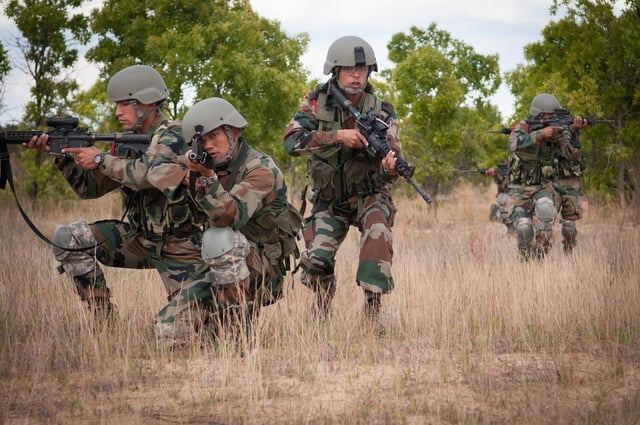
Indian Army soldiers move in to position while demonstrating a platoon level ambush to U.S Army paratroopers.

Indian army band in Russia during the Moscow Victory Day Parade.
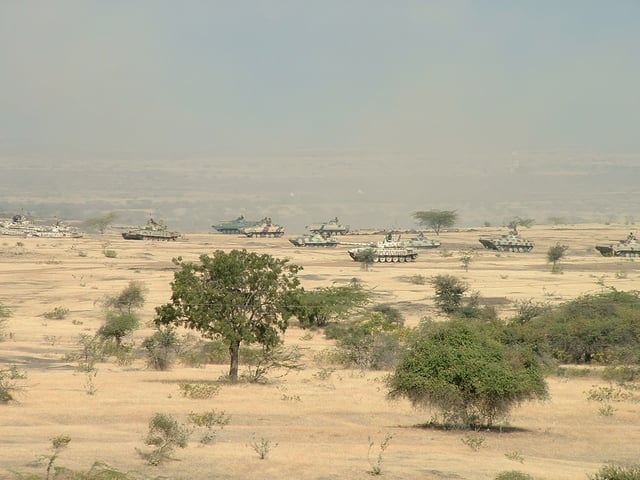
Indian Army Armoured Corps in 2006

Indian Army soldier during a training exercise.
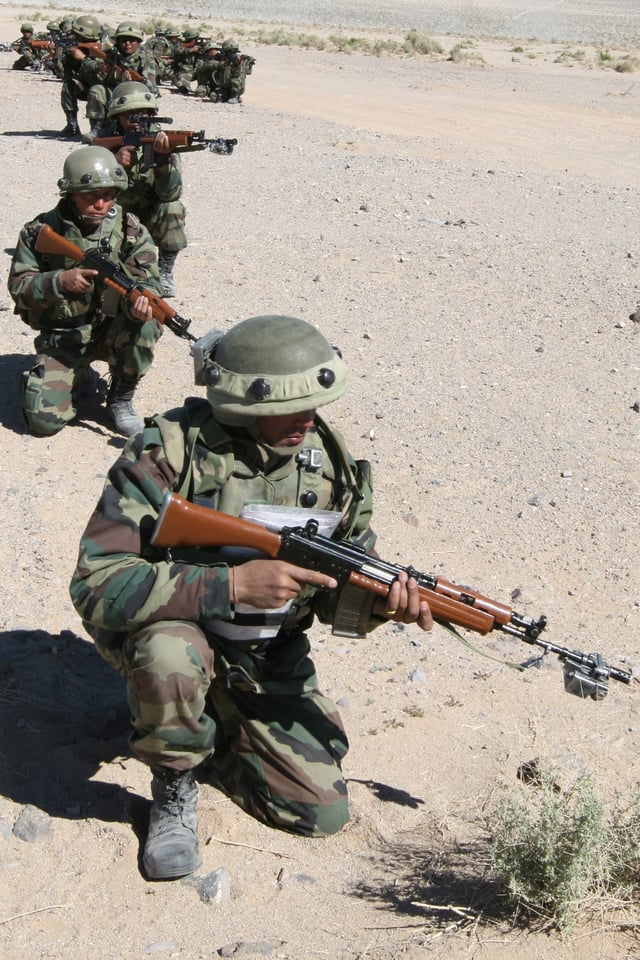
Indian Army Gorkha Rifles troopers, during a combat simulation in Fort Irwin, California.
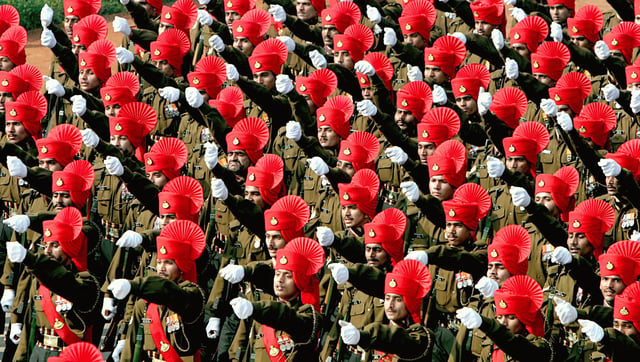
Soldiers of the Rajput Regiment during a Republic Day Parade

Soldiers of the Sikh Light Infantry during a Republic Day Parade
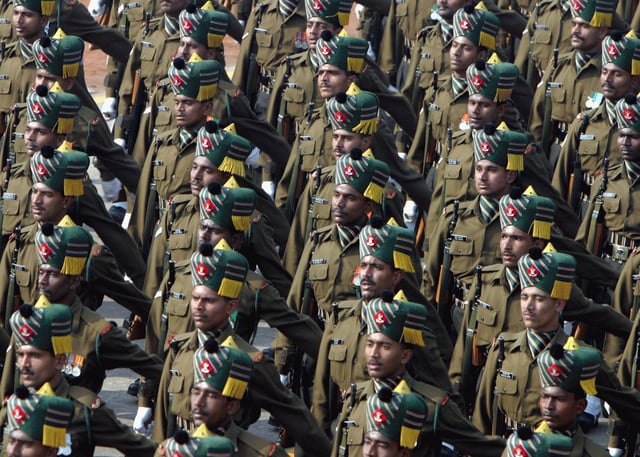
Soldiers of the Madras Regiment during a Republic Day Parade
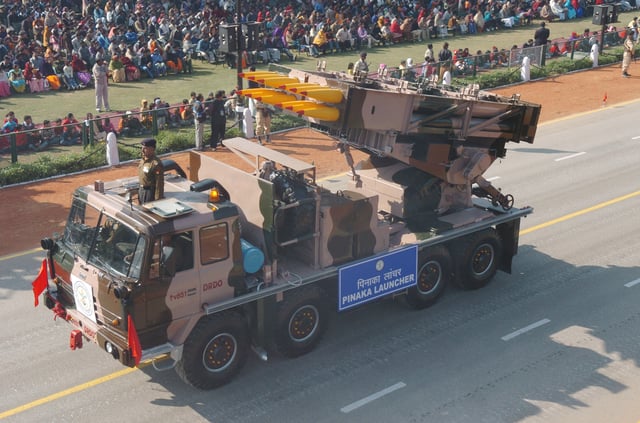
Pinaka Multi Barrel Rocket Launchers were used during the Kargil War.

Bofors artillery gun
Not to be confused with the Field Corps mentioned above, the corps mentioned below are the functional divisions entrusted with specific pan-Army tasks. The Indian Territorial Army has battalions affiliated with different infantry regiments and some department units which are either from the Corps of Engineers, Army Medical Corps or the Army Service Corps. They serve as a part-time reserve. On 4 June 2017, the chief of staff announced that the Army was planning to open combat positions to women, who would first be appointed to positions in the military police.
| Name | Director General | Center |
|---|---|---|
| Armoured Corps | The Armoured Corps Centre and School, Ahmednagar | |
| Regiment of Artillery | Lt General P. K. Srivastava, PVSM, AVSM, VSM[127][128] | The School of Artillery, Devlali near Nasik |
| Corps of Army Air Defence | Lt General A. P. Singh,[129] | Gopalpur, Odisha. |
| Army Aviation Corps | Lt General Kanwal Kumar[130] | Combat Army Aviation Training School, Nasik. |
| Corps of Engineers | Lt Gen S.K.Shrivastava,AVSM | College of Military Engineering, Pune Madras Engineer Group, Bangalore Bengal Engineer Group, Roorkee Bombay Engineer Group, Khadki near Pune |
| Corps of Signals | Lt General Rajeev Sabheral, AVSM, VSM[131] | Military College of Telecommunication Engineering (MCTE), Mhow Two Signal Training Centres at Jabalpur and Goa. |
| Mechanised Infantry | Ahmednagar | |
| Infantry |
Armoured Corps
There are 65 Armoured Regiments in the Indian Army (including the PBG and 61st Cavalry). These include the following historic regiments dating back to the nineteenth century or earlier: 1st (Skinner's) Horse, the 2nd Lancers (Gardner's Horse), the 3rd Cavalry, the 4th (Hodson's) Horse, the 7th Light Cavalry, the 8th Light Cavalry, the 9th (Deccan) Horse, the 14th (Scinde) Horse, the 17th (Poona) Horse, the 15th Lancers, the 16th Light Cavalry, the 18th Cavalry, the 20th Lancers and the 21st (Central India) Horse. A substantial number of additional units designated as either "Cavalry" or "Armoured" Regiments have been raised since Independence.
Mechanised Infantry
The Mechanised Infantry is the newest Combat Arm of the Indian Army. Often referred to as "tomorrow's arm in today's Army", it is formed of two Regiments; The Brigade of the Guards and Mechanised Infantry Regiment and comprises 48 Mechanised Infantry Battalions in all. The brain-child of raising of this arm was that of Gen Krishnaswamy Sundarji, PVSM (28 April 1930 – 8 February 1999), who was the Chief of Army Staff of the Indian Army from 1986 to 1988. During the late 70s, as part of Indian Army modernisation, there was an urgent need to re-calibrate the Indian Mechanised Forces by forming of Mechanised Infantry units to further the shock-action, fire-power, flexibility and mobility of Armoured formations to include ground-holding ability. Thus, the Mechanised Infantry Regiment was born by careful selection of existing Infantry battalions based on operational performance. As the need for more Mechanised battalions grew, the elite Brigade of The Guards were also converted to the Mechanised profile. The two Regiments along with the Armoured Corps form part of the Indian Army's elite "Mechanised Forces".
Infantry
Upon its inception, the Indian Army inherited the British Army's organisational structure, which is still maintained today. Therefore, like its predecessor, an Indian infantry regiment's responsibility is not to undertake field operations but to provide battalions and well trained personnel to the field formations. As such it is common to find battalions of the same regiment spread across several brigades, divisions, corps, commands, and even theatres. Like its British and Commonwealth counterparts, troops enlisted within the regiment are immensely loyal, take great pride in the regiment to which they are assigned, and generally spend their entire career within the regiment.
Most Indian Army infantry regiments recruit based on certain selection criteria, such as on the basis of region (for example, the Assam Regiment), caste/community (Jat Regiment), or religion (Sikh Regiment). Most regiments continue the heritage of regiments raised under the British Raj, but some have been raised after independence. Some regiments raised after independence have specialised in border defence, in particular the Ladakh Scouts, the Arunachal Scouts and the Sikkim Scouts.
Over the years there have been fears that troops' allegiance lay more with their regiments and the regions/castes/communities/religions from which they were recruited, as opposed to the union of India as a whole. Thus some "all India" or "all class" regiments have been created that recruit troops from all over India regardless of region, caste/community or religion, such as the Brigade of the Guards (which later converted to the Mechanised Infantry profile) and the Parachute Regiment.
| Regiment | Regimental Center | Raised |
|---|---|---|
| Parachute Regiment | Bangalore, Karnataka | 1945 |
| Punjab Regiment | Ramgarh Cantonment, Jharkhand | 1761 |
| Madras Regiment | Wellington Cantonment, Tamil Nadu | 1758 |
| The Grenadiers | Jabalpur, Madhya Pradesh | 1778 |
| Maratha Light Infantry | Belgaum, Karnataka | 1768 |
| Rajputana Rifles | Delhi Cantonment, New Delhi | 1775 |
| Rajput Regiment | Fatehgarh, Uttar Pradesh | 1778 |
| Jat Regiment | Bareilly, Uttar Pradesh | 1795 |
| Sikh Regiment | Ramgarh Cantonment, Jharkhand | 1846 |
| Sikh Light Infantry | Fatehgarh, Uttar Pradesh | 1857 |
| Dogra Regiment | Faizabad, Uttar Pradesh | 1877 |
| Garhwal Rifles | Lansdowne, Uttarakhand | 1887 |
| Kumaon Regiment | Ranikhet, Uttarakhand | 1813 |
| Assam Regiment | Shillong, Meghalaya | 1941 |
| Bihar Regiment | Danapur Cantonment, Bihar | 1941 |
| Mahar Regiment | Sagar, Madhya Pradesh | 1941 |
| Jammu & Kashmir Rifles | Jabalpur, Madhya Pradesh | 1821 |
| Jammu and Kashmir Light Infantry | Avantipur, Jammu and Kashmir | 1947 |
| Naga Regiment | Ranikhet, Uttarakhand | 1970 |
| 1 Gorkha Rifles | Sabathu, Himachal Pradesh | 1815 |
| 3 Gorkha Rifles | Varanasi, Uttar Pradesh | 1815 |
| 4 Gorkha Rifles | Sabathu, Himachal Pradesh | 1857 |
| 5 Gorkha Rifles (Frontier Force) | Shillong, Meghalaya | 1858 |
| 8 Gorkha Rifles | Shillong, Meghalaya | 1824 |
| 9 Gorkha Rifles | Varanasi, Uttar Pradesh | 1817 |
| 11 Gorkha Rifles | Lucknow, Uttar Pradesh | 1918 |
| Ladakh Scouts | Leh, Jammu and Kashmir | 1963 |
| Rashtriya Rifles | 1990 | |
| Arunachal Scouts | Shillong, Meghalaya | 2010 |
| Sikkim Scouts | 2013 |
Artillery
The Regiment of Artillery is the second largest arm of the Indian Army, constituting nearly one sixth of the Army's total strength. Originally raised in 1935 as part of the Royal Indian Artillery of the British Indian Army, the Regiment is now tasked with providing the Army's towed and self-propelled field artillery, including guns, howitzers, heavy mortars, rockets and missiles.
As an integral part of nearly all combat operations conducted by the Indian Army, the Regiment of Artillery has a history of being a major contributor to Indian military success. During the Kargil War, it was the Indian Artillery that inflicted the most damage.[133] Over the years, five artillery officers have gone on to the Army's highest post as Chief of Army Staff of the Indian Army.
For some time, the Regiment of Artillery commanded a significantly larger share of the Army's personnel than it does now, as it was also responsible for air defense artillery and some aviation assets. The 1990s saw the formation of the Corps of Army Air Defence and the coalescing of all aviation assets into the Army Aviation Corps. The arm is now focused on field artillery, and supplies regiments and batteries to each of the operational commands. The home of the Regiment is in Nashik, Maharashtra, where their headquarters is located along with the service's museum. The School of Artillery of the Indian Army is located nearby in Devlali.
After undergoing consistent failures to import or produce modern artillery for three decades,[134][135] the Regiment of Artillery is finally going ahead with procurement of brand new 130-mm and 155-mm artillery guns.[136][137][138] The Army is also putting large numbers of rocket launchers into service, with the indigenously-developed Pinaka multi barrel rocket launcher to equip 22 regiments by the end of the next decade.[139]
Corps of Engineers
Madras Engineer Group
Bengal Engineer Group
Bombay Engineer Group
The Indian Army Corps of Engineers has a long history dating back to the mid-18th century. The earliest existing subunit of the Corps (18 Field Company) dates back to 1777 while the Corps officially recognises its birth as 1780 when the senior most group of the Corps, the Madras Sappers were raised. The Corps consists of three groups of combat engineers, namely the Madras Sappers, the Bengal Sappers and the Bombay Sappers. A group is roughly analogous to a regiment of Indian infantry, each group consisting of a number of engineer regiments. The engineer regiment is the basic combat engineer unit, analogous to an infantry battalion.
Corps of Signals
Indian Army Corps of Signals is a corps and the arm of the Indian Army which handles its military communications. It was formed on 15 February 1911 as a separate entity under Lieutenant Colonel S H Powell, and went on to make important contributions to World War I and World War II.[140] The corps celebrated its 100-year anniversary of its raising on 15 February 2011.[141]
Army Aviation Corps
The Army Aviation Corps, formed on 1 November 1986, is a component of the Indian Army. The aviation arm is headed by a Director General of the rank of Lt General at the Army HQ, New Delhi.
Corps of Army Air Defence
The Corps of Army Air Defence (abbreviated as AAD) is an active corps of the Indian Army and a major combative formation tasked with air defences of the country from foreign threats. The AAD Corps is responsible for the protection of Indian air space from enemy aircraft and missiles, especially below 5,000 feet.[142]
The history of the AAD dates back to 1939 during the times of the British Raj in India. The corps actively took part in the Second World War fighting on behalf of the British Empire. Post independence, the corps has participated in all the wars involving India, starting from the 1947 Indo-Pakistani War to the 1999 Kargil conflict. The corps enjoyed autonomous status from 1994, after the bifurcation of the Corps of Air Defence Artillery from the Army's artillery regiment. A separate training school, the Army Air Defence College (AADC), was established to train its personnel.
Para (Special Forces)
Para (Special Forces), commonly known as Para SF, is the special operations unit of Indian Army. It is part of the Bangalore based Parachute Regiment.
Services
| Name | Director General | Centre |
|---|---|---|
| Army Service Corps | Lt General M. H. Thakur[143] | Bangalore |
| Army Medical Corps | Lt General Velu Nair, AVSM, VSM[144] | Lucknow/Pune |
| Army Dental Corps | Lt General T. K. Bandyopadhyay[145] | Lucknow |
| Army Ordnance Corps | Lt General Amit Sarin[146] | Jabalpur and Secunderabad (HQ) |
| Corps of Electronics and Mechanical Engineers | Lt General K. K. Agarwal[147] | Secunderabad(Hyderabad) |
| Remount and Veterinary Corps | Lt General A. J. Singh, VSM[148] | Meerut |
| Army Education Corps | Major General Sunil Chandra[149] | Pachmarhi |
| Corps of Military Police | Bangalore | |
| Pioneer Corps | Bangalore | |
| Army Postal Service Corps | Major General P. S. Negi[150] | Kamptee near Nagpur |
| Territorial Army | Major General D. A. Chaturvedi[151] | |
| Defence Security Corps | Kannur Cantonment, Kerala | |
| Intelligence Corps | Pune | |
| Judge Advocate General's Department | Institute of Military Law Kamptee, Nagpur | |
| Military Nursing Service | Major General Joyce Gladys Roach[152] | Pune and Lucknow |
Training
Pre-commission training of Gentlemen Cadets is carried out at the Indian Military Academy at Dehradun and the Officers Training Academy at Chennai. There are also specialised training institutions like the Army War College, at Mhow, Madhya Pradesh, the High Altitude Warfare School (HAWS), at Gulmarg, Jammu and Kashmir, the Counter Insurgency and Jungle Warfare School (CIJW), in Vairengte, Mizoram, and the College of Military Engineering (CME), in Pune. There is an Army Training Command (ARTRAC) at Shimla, whose main aim is to maximise the effectiveness of the training of personnel.
Intelligence
The Directorate of Military Intelligence (DMI) is the Intelligence arm of the Indian Army. The MI (as it is commonly referred to) was constituted in 1941 and was initially created to check corruption in the Army's own ranks. With time, its role has evolved into cross border intelligence, intelligence sharing with friendly nations, infiltrating insurgent groups and counter-terrorism. In the late 1970s, the MI was embroiled in the Samba spy scandal wherein three Indian Army officers were falsely implicated as Pakistani spies. The organisation has since emerged from the scandal as a prime Intelligence organisation of the Indian Army. As of 2012, the MI has seen many of its roles taken away by the newly created National Technical Research Organisation and the Defence Intelligence Agency.[153] Since it was set up in 2004 as a premier apex scientific agency under the National Security Adviser in the Prime Minister's Office, it also includes the National Institute of Cryptology Research and Development (NICRD), which is the first of its kind in Asia.[154]
Field formations
Below are the basic field formations of the Indian Army:
Command: Indian Army has six operational commands and one training command. Each one is headed by a general officer commanding-in-chief (GOC-in-C), known as the army commander, who is among the seniormost lieutenant general officers in the army.
Corps: A command generally consists of two or more corps. Indian Army has 14 Corps each one commanded by a general officer commanding (GOC), known as the corps commander, who holds the rank of lieutenant general.[114] Each corps is composed of three or four divisions. There are three types of corps in the Indian Army: Strike, Holding and Mixed. The Corps HQ is the highest field formation in the army.[155]
Division: Each division is headed by GOC (division commander) in the rank of major general.[114] It usually consists of three to four Brigades.[114] Currently, the Indian Army has 40 Divisions[156] including four RAPIDs (Re-organised Army Plains Infantry Division), 18 Infantry Divisions, 12 Mountain Divisions, three Armoured Divisions and three Artillery Divisions.
Brigade: A brigade generally consists of around 3,000 combat troops with supporting elements. An Infantry Brigade usually has three Infantry battalions along with various Support Elements.[114] It is commanded by a brigade commander who is a Brigadier,[114] equivalent to a brigadier general in some armies. In addition to the Brigades in various Army Divisions, the Indian Army also has five Independent Armoured Brigades, 15 Independent Artillery Brigades, seven Independent Infantry Brigades, one Independent Parachute Brigade, three Independent Air Defence Brigades, two Independent Air Defence Groups and four Independent Engineer Brigades. These Independent Brigades operate directly under the Corps Commander (GOC Corps).
Battalion: Composed of four rifle companies.[114] Commanded by a battalion commander who is a Colonel[114] and is the Infantry's main fighting unit. Every infantry battalion also possesses one Ghatak Platoon.[157]
Company: Composed of three platoons.[114] Commanded by a company commander who is a major or lieutenant-colonel.[114]
Platoon: Composed of three sections.[114] Commanded by a platoon commander who is a JCO.[114]
Section: Smallest military outfit with a strength of 10 personnel. Commanded by a section commander of the rank of Havaldar.[114]
Indian Army forts
Fort William, Kolkata: Garrison of Eastern Army Command
Fort St George, Chennai: Garrison of ATNK&K Army Area
OD Fort, Allahabad, Ordnance Depot
Personnel
The Indian Army is a voluntary service, and although a provision for military conscription exists in the Indian constitution, it has never been imposed. As of 1 July 2017, the Indian Army has a sanctioned strength of 49,932 officers (42,253 serving with 7,679 under strength), and 1,215,049 enlisted personnel (1,194,864 serving with 20,185 under strength).[12][13] Recently, it has been proposed to enhance the strength of the army by more than 90,000 to counter the increasing presence of Chinese troops along the Line of Actual Control.[158][159] According to the International Institute for Strategic Studies, in 2017 the army had a strength of 1,200,000 active personnel and 960,000 reserve personnel.[160] Of those in reserve, 300,000 are first-line reserve (within 5 years of service), 500,000 are committed until the age of 50 and 160,000 were in the Indian Territorial Army, with 40,000 in regular establishment. This makes the Indian Army the world's largest standing volunteer army.[161][162]
Rank Structure
The ranks of the Indian Army for the most part follow the British Army tradition.
Commissioned Officers
Commissioned officers are the leaders of the army and command everywhere from platoon/company to brigade, division, corps and the whole army.
Indian Army officers are continually put through different courses and assessed on merit throughout their career, for promotions and appointments. Substantive promotions up to lieutenant colonel or equivalent are based on time in service whereas those for colonel and above are based on selection, with promotion to colonel also based on time served.
| Equivalent NATO code | OF-10 | OF-9 | OF-8 | OF-7 | OF-6 | OF-5 | OF-4 | OF-3 | OF-2 | OF-1 |
|---|---|---|---|---|---|---|---|---|---|---|
| **Shoulder Insignia** | ||||||||||
| Rank | Field Marshal1 | General2 | Lieutenant General | Major General | Brigadier | Colonel | Lieutenant Colonel | Major | Captain | Lieutenant |
| ||||||||||
Other Ranks
Uniforms
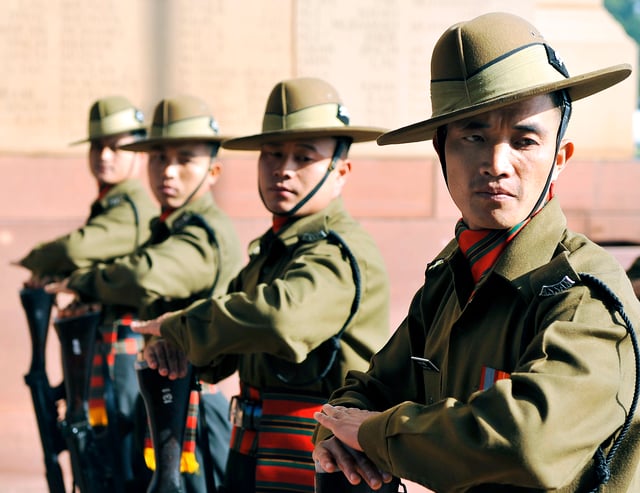
Soldiers of the Assam Regiment
The Indian Army camouflage consists of shirts, trousers and cap of a synthetic material. Shirts are buttoned up with two chest pockets with buttoned up flaps. Trousers have two pockets, two thigh box pockets and a back pocket. The Indian Army Jungle camouflage dress features a jungle camouflage pattern and is designed for use in woodland environments. The Indian Army Desert camouflage, which features a desert camouflage pattern, is used by artillery and infantry posted in dusty, semi-desert and desert areas of Rajasthan and its vicinity.
The forces of the East India Company in India were forced by casualties to dye their white summer tunics to neutral tones, initially a tan called khaki (from the Hindi word for "dusty"). This was a temporary measure which became standard in the Indian service in the 1880s. Only during the Second Boer War in 1902, did the entire British Army standardise on dun for Service Dress. The Indian Army uniform standardises on dun for khaki. The modern Indian Army wears distinctive parade uniforms characterised by variegated turbans and waist-sashes in regimental colours. The Gurkha and Garwhal Rifles and the Assam, Kumaon and Naga Regiments wear broad brimmed hats of traditional style. Traditionally, all rifle regiments (the Jammu and Kashmir Rifles, the Garhwal Rifles, all Gorkha Rifles, and the Rajputana Rifles) as well as the Jammu and Kashmir Light Infantry wear rank badges, buttons and blackened wire embroidered articles of uniform in black instead of the usual brass (or gold) colour as the original role of the rifle regiments was camouflage and concealment.
Medals and awards
The medals awarded by the President of India for gallantry displayed at the battlefield, in order of precedence, are- Param Vir Chakra, Maha Vir Chakra and Vir Chakra.
The medals awarded by the President for gallantry displayed away from the battlefield, in order of precedence, are- Ashoka Chakra, Kirti Chakra and Shaurya Chakra.
Many of the recipients of these awards have been Indian Army personnel.
Women
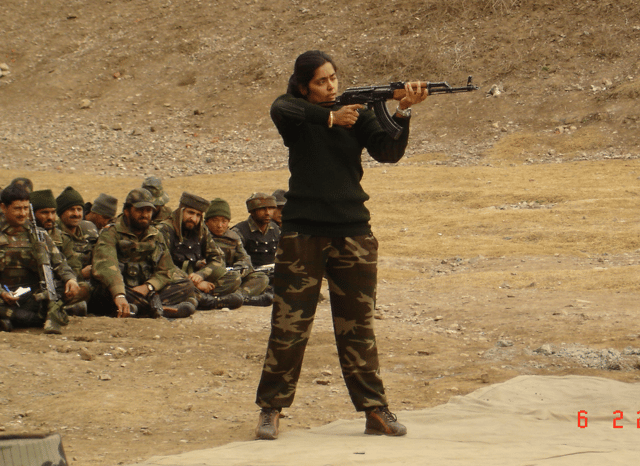
A female officer in the Indian Army briefing soldiers on firing techniques.
The role of women in the Indian army began when the "Indian Military Nursing Service" was formed in 1888, and nurses fought in World War I and II where 350 Indian Army nurses either died or were taken prisoner of war or declared missing in action, this includes nurses who died when SS Kuala was sunk by the Japanese Bombers in 1942.[163] In 1992, the Indian Army began inducting women officers in non-medical roles.[164] On 19 January 2007, the United Nations first all female peacekeeping force made up of 105 Indian policewomen was deployed to Liberia.[165] In 2014, India's army had 3 per cent women, the Navy 2.8 per cent and the Air Force, the highest, with 8.5 per cent women.[166] In 2015 India opened new combat air force roles for women as fighter pilots, adding to their role as helicopter pilots in the Indian Air Force.[167]
Equipment

Akash Surface to Air Missile
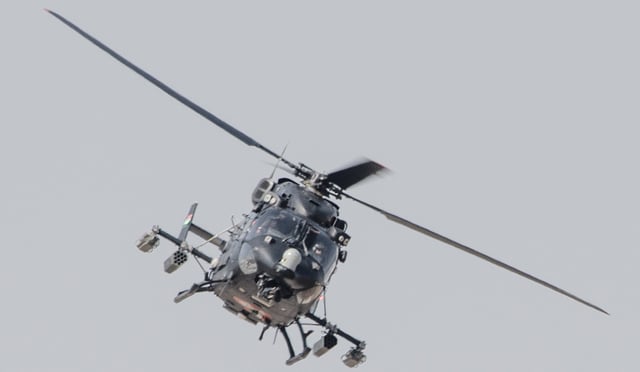
HAL Rudra
Most of the army equipment is imported, but efforts are being made to manufacture indigenous equipment. The Defence Research and Development Organisation has developed a range of weapons for the Indian Army ranging from small arms, artillery, radars and the Arjun tank. All Indian Military small-arms are manufactured under the umbrella administration of the Ordnance Factories Board, with principal Firearm manufacturing facilities in Ichhapore, Cossipore, Kanpur, Jabalpur and Tiruchirapalli. The Indian Small Arms System (INSAS) rifle, which has been successfully inducted by Indian Army since 1997, is a product of the Rifle Factory Ishapore, while ammunition is manufactured at Khadki and possibly at Bolangir.
In 2014, Army chief General Bikram Singh said that if given sufficient budget support, the Indian Army might be able to acquire half the ammunition needed to fight in a major conflict by the next year.[168]
Aircraft - The Army Aviation Corps is the main body of the Indian Army for tactical air transport, reconnaissance, and medical evacuation, while the Indian Air Force's helicopter assets are responsible for assisting the army troop transport and close air support. It operates around 150 helicopters. The Indian army had projected a requirement for a helicopter that can carry loads of up to 750 kilograms (1,650 lb) to heights of 23,000 feet (7,000 m) on the Siachen Glacier in Jammu and Kashmir. Flying at these heights poses unique challenges due to the rarefied atmosphere. The Indian Army will induct the HAL Light Utility Helicopter to replace its ageing fleet of Chetaks and Cheetahs, some of which were inducted more than three decades ago.[169]
On 13 October 2012, The defence minister has given the control of attack helicopters to the Indian Army from the Indian Air force.[170]
Future developments
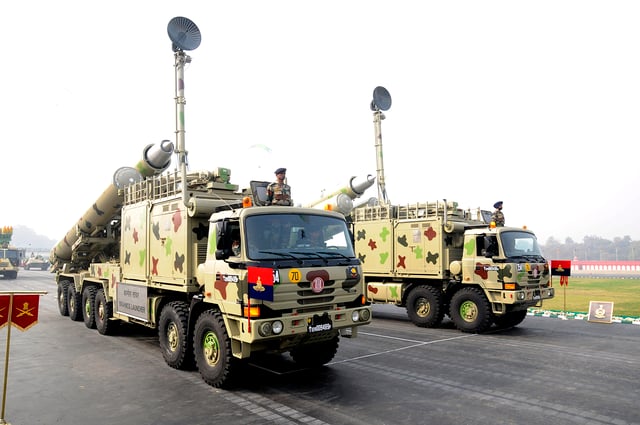
The Brahmos supersonic cruise missile is a crucial component of the Indian Army's strike capabilities.

Advanced Air Defence (AAD) missile launch, 2008
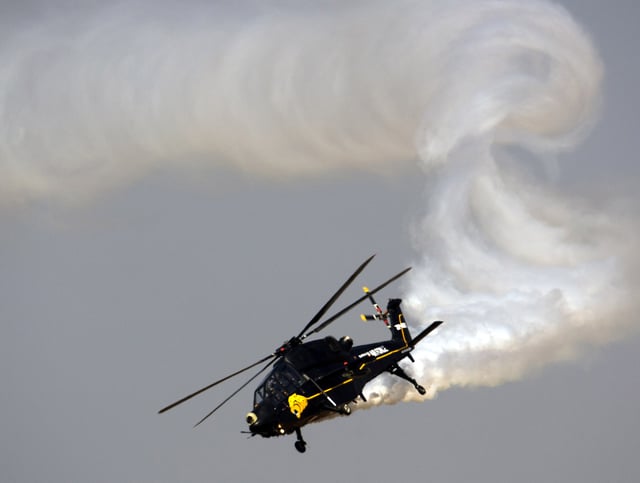
HAL Light Combat Helicopter
F-INSAS is the Indian Army's principal infantry modernisation programme, which aims to modernise the army's 465 infantry and paramilitary battalions by 2020. The programme aims to upgrade the infantry with a multi-calibre rifle with an under-barrel grenade launcher and bulletproof jackets and helmets. The helmet would include a visor, flashlight, thermal sensors, night vision devices and a miniature computer with audio headsets. It will also include a new lightweight and waterproof uniform, which would help the soldier in carrying extra load and fighting in an NBC environment.[171]
India is currently re-organising its mechanised forces to achieve strategic mobility and high-volume firepower for rapid thrusts into enemy territory. India proposes to progressively induct as many as 248 Arjun MBT and to develop and induct the Arjun MK-II variant, 1,657 Russian-origin T-90S main-battle tanks (MBTs). The army is procuring 2,000 pieces of night vision devices for T-72 tanks for Rs 10 billion; 1,200 pieces for T-90 tanks for Rs 9.60 billion and 1,780 pieces for infantry combat vehicles for Rs 8.60 billion. It is also acquiring 700 TISAS (thermal imaging stand alone systems) and 418 TIFACS (thermal fire control systems) for its T-72 fleet at a cost of around $230 million. 300 Israeli TISAS were installed as part of several T-72 upgrade phases, followed by 3,860 image intensifier-based night-vision devices. 310 Russian produced T-90S Main Battle Tanks were also fitted with French Catherine TI cameras.[172][173]
The Cabinet Committee on Security approved raising two new infantry mountain divisions (with around 15,000 combat soldiers each) and an artillery brigade in 2008. These divisions were likely to be armed with ultralight howitzers.[174] In July 2009, it was reported that the Army was advocating a new artillery division. The proposed artillery division, under the Kolkata-based Eastern Command, was to have three brigades – two of 155 mm howitzers and one of the Russian "Smerch" and indigenous "Pinaka" multiple-launch rocket systems.[175]
The major ongoing weapons programmes of the Indian Army are as follows:
- Tanks and Armoured vehicles
Arjun MK-III[176]
Futuristic Battle Tank (FMBT) – The FMBT will be a lighter tank of 50 tons. At conceptual stage.
Abhay IFV – Future Infantry Combat Vehicle
TATA Kestrel -A modern armoured personnel carrier developed by Tata Motors and the Defence Research and Development Organisation (DRDO). It is developed with the intention to replace age old Soviet era BMPs and APCs in service with Indian army. Expected to join Indian Army by 2017.
- Missiles
Intercontinental Ballistic Missiles Agni-V – 5,500 km (3,400 mi)–8,000 km (5,000 mi) Successfully Tested third time canistered version by DRDO on 31 January 2015. Agni-VI – 8,000 km (5,000 mi)–12,000 km (7,500 mi) range with MIRVed warheads. Currently in planning stage.
Cruise Missiles Hypersonic missile Nirbhay Missile BrahMos – M
Tactical Ballistic Missiles Prahaar (missile) – With a range of 150 kilometres (93 mi).[177] Shaurya (missile) – It has a range of between 750 km (470 mi)-1,900 km (1,200 mi)
Anti-Tank Guided Missiles Nag Anti-tank guided missile – ground and air-launched variant.
The Indian Ballistic Missile Defence Programme is an initiative to develop and deploy a multi-layered ballistic missile defence system to protect India from ballistic missile attacks. It is a double-tiered system consisting of two interceptor missiles, namely the Prithvi Air Defence (PAD) missile for high altitude interception, and the Advanced Air Defence (AAD) Missile for lower altitude interception.[178][179]
- Vehicles
Tata Motors offers a full range 6×6, 8×8 and 12×12 multi-purpose high mobility carriers, designed especially for integrating specialist rocket and missile systems. Tata 2038 6×6 vehicle platform also stands qualified by the Indian Army for GRAD BM21 Multi Barrel Rocket Launcher (MBRL) application after rigorous field firing evaluation trials.
Mahindra Axe – Light utility vehicle to be purchased.
The army needs 3,000 light support vehicles and 1600 heavy motor vehicles for mounting rockets and radar, and for reconnaissance and transportation at the cost of Rs 15 billion.[180]
- Artillery
Under the Field Artillery Rationalisation Plan, the army plans to procure 3000 to 4000 pieces of artillery at the cost of ₹200 billion (US$3 billion). This includes purchasing 1580 towed, 814 mounted, 180 self-propelled wheeled, 100 self-propelled tracked and 145 ultra-light 155 mm/39 calibre artillery guns. The requirement for artillery guns would be met with indigenous development and production.[181]
- Small Arms
Excalibur rifle – Replacement for the INSAS rifle in service.[182]
Multi Caliber Individual Weapon System (MCIWS)
Modern Sub Machine Carbine – The Modern Sub Machine Carbine (MSMC) is the latest combined venture of ARDE & OFB, developed for the Indian Army on a platform of experiences from the INSAS rifle. RFI's worth ₹220 billion (US$3 billion) were issued for assault rifles, carbines, pump-action shotguns, sniper rifles, anti-material rifles, general purpose machine guns and heavy machine guns.
- Army Aviation
Procurement process for 197 light utility helicopters (LUH) has been scrapped, of which 64 will be inducted in the Army Aviation to replace the Cheetak and Cheetah Helicopters.
HAL Light Utility Helicopter (LUH);– requirement for 384 helicopters for both the army and air force.
HAL has obtained a firm order to deliver 114 HAL Light Combat Helicopters to the Indian Army.[183]
See also
Centre for Land Warfare Studies
List of serving Generals of the Indian Army
Paramilitary forces of India
Army Day (India)

